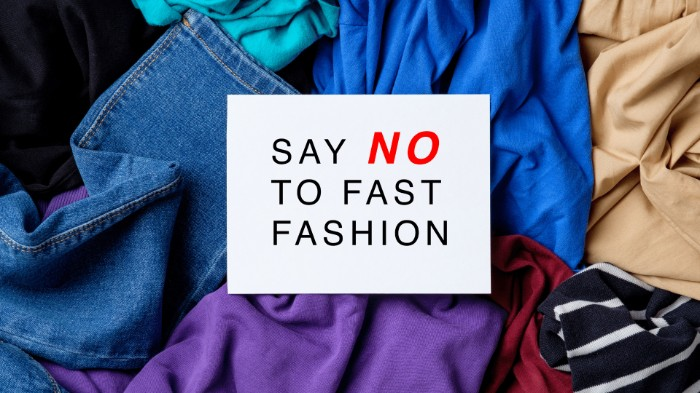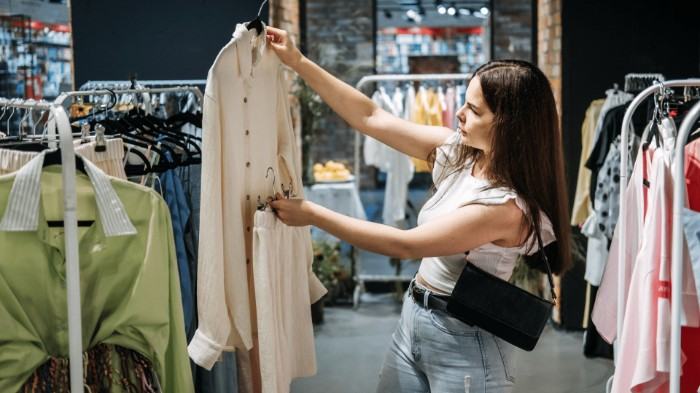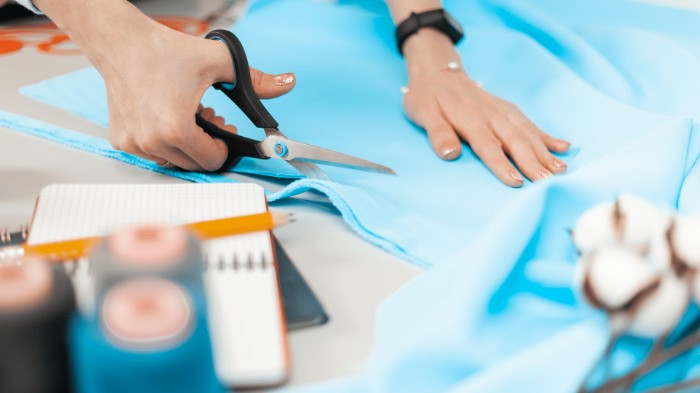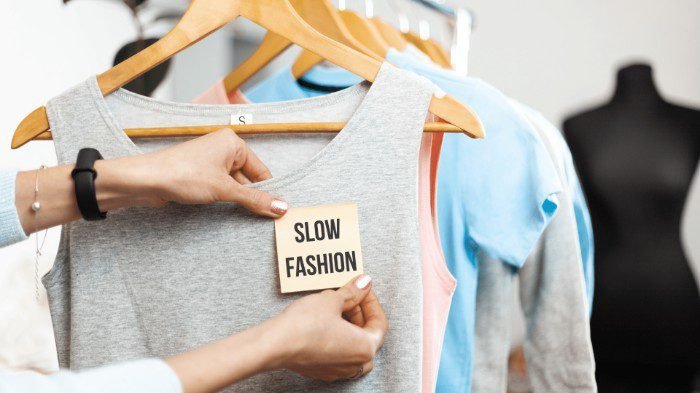In today’s world of disposable fashion, we are becoming increasingly reliant on fast fashion to keep up with the latest trends. Fast fashion is defined as cheaply made clothing produced quickly by mass-market retailers in order to adapt to the latest trends.
However, although it has its perks, fast fashion is having negative impacts on both people and the planet. The labor practices involved in creating these clothes raise serious ethical concerns, and their production causes significant environmental degradation. Now more than ever, it is necessary to promote and invest in sustainable alternative methods of producing clothes that prioritize people and the planet instead of profit.
If you’re interested in learning more about this mindful approach to shopping, keep reading. We’ll explain what slow fashion is, why it’s important, and how you can get involved.
- Why do we need the opposite of fast fashion?
- FAQs
Why do we need the opposite of fast fashion?

The fast fashion industry is having devastating impacts on both people and the planet. Garment workers around the world are paid far below living wages, with conditions such as physical violence, child labor, long working hours, and exposure to toxic chemicals being commonplace.
Additionally, due to the inexpensive nature of fast fashion garments, they are often disposed of shortly after being worn once or twice, leading to a huge amount of waste being sent directly into landfills. Other times, they are burned which causes even more toxic emissions for the environment to absorb. It is clear that if we want a better future for all, we must challenge the current industry norms and move towards a model that prioritizes people over profit while also protecting our environment from further harm.
Investing in an opposite approach to fashion production allows us to create clothes that are sustainable both socially and environmentally. By investing in ethical labor practices such as fair wages, safe working conditions, and better overall treatment of garment workers around the world, we can slowly start moving away from exploitative practices that have evolved in the fashion industry over time.
Similarly, switching away from traditional fabric production processes, such as those that rely heavily on harmful chemicals or result in excessive water waste, will help safeguard our environment by reducing pollution levels as well as decrease water insecurity in many parts of the world where water availability is already low.
What needs immediate attention, however, is how these changes can be achieved without putting small companies out of business or resulting in increased costs for consumers who may not have access to higher-priced alternatives because of budget restraints.
Campaigns such as ‘Sustainable Fashion Day’ or the ‘Slow Fashion Movement’ aim to educate consumers about the sustainable alternatives available today. By raising awareness about sustainable materials and options, businesses are encouraged to choose more eco-friendly materials when making clothes. This, in turn, provides more accessible options for consumers who may not be able to afford more expensive high-end pieces but still would like access to trendier sustainable options at lower price points.
What is the slow fashion movement?
Slow fashion is a movement that has been gaining traction in recent years. It emphasizes the quality and longevity of clothing, encourages sustainable practices, and prioritizes ethically produced garments.

Unlike fast fashion, which relies on a system of mass production and consumption of cheaply made products that are quickly cycled through stores, slow fashion takes the opposite approach. Slow fashion focuses on quality over quantity, creating pieces that last longer and use fewer natural resources to make them. These items will cost more upfront but often save money in the long run because they don’t need to be replaced so frequently.
The goal of the slow fashion movement is to create long-lasting, sustainable clothing that is better for the environment and for the people who make and wear it.
What are the benefits of slow fashion?

There are countless benefits to slow fashion that should not be overlooked:
1. Better quality
While mass-produced fast fashion is often made quickly and cheaply, resulting in lower-quality garments, slow fashion takes a more sustainable and mindful approach. Garments produced through slow fashion typically have high-quality materials. This can result in higher-quality clothing that is made to last longer, which is not only better for the environment but also for the consumer.
2. Saves money
Fast fashion is all about keeping up with the latest trends, often at the expense of quality. Slow fashion, on the other hand, focuses on timeless style and durability. In the short term, fast fashion may seem like the more affordable option. However, over time, slow fashion actually saves money. That’s because slow fashion pieces are designed to last for years if not decades. They can be handed down to future generations or sold second-hand when you’re ready for a change. In contrast, fast fashion pieces quickly fall apart and end up in landfill. As a result, slow fashion is not only better for your wardrobe but also your wallet.
3. Reduces consumption
Slow fashion encourages conscious consumption. Instead of buying into trends or fads that come and go each season, consumers can choose timeless pieces that they truly love and will wear frequently. This also reduces overall consumption and supports more responsible textile production methods in turn.
4. Supports local communities
When clothes are produced slowly, they are more likely to be made in small batches by local artisans. This supports the local economy and keeps money within the community. In addition, slow fashion often uses sustainable materials that are locally sourced materials, like hemp, from farmers and other suppliers. This helps to further support the local community while also being kinder to the environment.
5. Supports fair working conditions
In an industry that is notorious for its exploitation of factory workers, slow fashion provides an opportunity to improve working conditions and create fair-trade products. When clothes are produced quickly and cheaply, it often leads to subpar working conditions and low wages for employees. By contrast, slow-fashion garments are typically made by artisans who are paid a living wage for their work.
6. Saves water
Fast fashion generally needs more water at an alarming rate to produce due to the number of garments being produced at one time. And all of that water is often dumped straight into the local water system, chemicals and all. Slow fashion takes its time to make each individual garment with care which in turn doesn’t require as much water. Slow fashion helps to cut down on water usage, as less water is used during the production process when the fabric is given time to dry instead of being rushed through a more intensive process.
7. Reduces waste
Slow fashion takes into account the entire lifecycle of a garment, from the sourcing of materials to the end of its life. This means that designers are more likely to choose sustainable materials and create garments that will stand the test of time. As a result, slow fashion helps to reduce the amount of textile waste that ends up in landfills each year. In addition, slow fashion encourages consumers to value their clothing and take better care of their garments, further reducing waste.
8. Feels good
Slow fashion is ethical and sustainably sourced, which will provide a sense of gratification about your apparel. When you take the time to find clothes that you really love, and that are well-made and will last, you can feel good knowing that you have made a wise investment. You can also take pride in knowing that you are supporting ethical and sustainable fashion brands. And, when you get compliments on your outfit, you can feel extra gratified knowing that you look great and are making a positive impact on the world. It is a healthy part of green living which directly contributes to your personal ESG score.
9. Reduces carbon footprint
Slow fashion apparel helps to reduce the carbon footprint of the fashion industry. The fashion industry is one of the most polluting industries in the world, responsible for a huge amount of greenhouse gas emissions. By choosing to buy fewer, better-made clothes, we can help to reduce the demand for new clothing and lower the emissions associated with production.
10. Better Health
When you buy slow fashion, you are not only getting a garment that will last longer, but you are also getting a garment that is better for your health. The chemicals used in fast fashion are often toxic and can cause skin irritations and respiratory problems. Slow fashion brands are much more likely to use natural fabrics and dyes that are gentle on the skin and won’t cause long-term health problems.
11. Ethical supply chains
Ethical supply chain management adheres to moral and ethical standards in order to protect workers, local economies, and the environment. In an industry notorious for its exploitation, child labor, and pollution, slow fashion is a much-needed breath of fresh air. Consumers are becoming more aware of the importance of ethical supply chains and are using their spending power to vote with their wallets. As a result, we are seeing a shift towards more sustainable and ethical fashion brands. This is good news for everyone involved in the fashion industry, from the farmers who grow the cotton to the workers in the textile mills. We can all play a part in supporting ethical supply chains by choosing to buy slow fashion. Look for the B-Corporation designation and ask about their ESG strategy.
12. Supports animal welfare
One of the biggest benefits of slow fashion is that it supports animal welfare. The use of synthetic materials such as polyester and nylon in fast fashion production often involves cruel practices such as force-feeding and live-plucking. In contrast, a slow fashion brand is much more likely to use natural fibers such as organic cotton and wool, which are produced without harming animals. Furthermore, many slow fashion brands take steps to ensure that their workers treat animals humanely, such as ensuring that they are not overworked or exposed to harsh chemicals. As a result, consumers can feel good about supporting slow fashion brands that are committed to animal welfare.
How can we take part in the sustainable fashion movement?

The fashion industry is one of the most polluting industries in the world. Every year, billions of pieces of apparel are produced, and most of them end up in the landfill. In order to take part in the sustainable fashion movement, we need to be more mindful of our shopping by changing our habits. Instead of buying whatever is cheap or trendy, we should take the time to investigate brands’ production methods. We should also choose eco-friendly brands that prioritize ethical practices and sustainability over cheaper prices or up-to-date trends. By making more sustainable fashion choices, we can help to reduce the environmental impact of the fashion industry. Look for the Certified B-Corp designation from companies.
In Conclusion, the opposite of fast fashion.
The exact opposite of fast fashion: the slow fashion approach is centered around creating clothing pieces with more thoughtfulness when it comes to how they were made, considering their environmental footprint, their economic impact on garment workers, and how long they will last before needing replacing. Taking part in this movement means investigating fast fashion brands’ garment production methods before making a purchase and choosing those who prioritize ethical practices and sustainability over lower prices or up-to-date trends. And while it may be tempting to buy something new all the time, by investing in quality items that you can wear year after year, you’ll not only save money but also join a wave of conscious consumerism that helps protect our planet and its people. So, let’s try to be the opposite of fast.
FAQs

How can the fashion industry become sustainable?
The fashion industry has a major sustainability problem. It’s been estimated that the clothing and textile industry is responsible for 10% of annual global carbon emissions and is the second-largest consumer of water globally. There are a number of ways that the clothing industry can become more sustainable, including using more recycled materials, and natural materials, building from raw materials, and using renewable energy. Additionally, the fashion industry can minimize waste by cutting down on overproduction and using organic hemp, recycled cotton, and other environmentally friendly fabrics. Taking these steps can help reduce the environmental impact resulting in a more sustainable fashion industry.
What is vegan-friendly clothing?
Vegan-friendly clothing does not use any animal products in its manufacture, such as items made from leather, wool, silk, and down. Vegan-friendly clothing is often made from plant-based materials such as organic cotton, linen, and hemp. However, it can also be made from synthetic materials such as polyester and nylon. While vegan-friendly clothing is often more expensive than conventional clothing, it is becoming more widely available as the demand for humane and sustainable fashion grows.
What are the benefits of hemp apparel?
Hemp is a sustainable fiber that is environmentally friendly and has many benefits to it. Hemp apparel is made from natural materials with a diverse range of qualities including lightweight, breathable, strong, and durable. It is also resistant to mold, mildew, and insect damage. Hemp clothing can be worn in any season as it maintains a comfortable temperature in cooler weather and wicks away moisture in warmer climates. Hemp fabric is one of many sustainably sourced fabrics for clothes that are anti-microbial and hypoallergenic, making it an ideal choice for those with sensitive skin. Additionally, hemp apparel is of higher quality because it helps to protect you from harmful UV rays from the sun due to its natural SPF properties. Hemp clothing can be easily washed and won’t fade or shrink in the wash like other fabrics. Lastly, hemp apparel is an affordable choice that can last for many years with proper care and maintenance. With all these great benefits, it’s easy to see why hemp apparel is becoming a popular choice in the slow fashion industry. Which makes it the exact opposite of fast fashion.

Dean Emerick is a curator on sustainability issues with ESG The Report, an online resource for SMEs and Investment professionals focusing on ESG principles. Their primary goal is to help middle-market companies automate Impact Reporting with ESG Software. Leveraging the power of AI, machine learning, and AWS to transition to a sustainable business model. Serving clients in the United States, Canada, UK, Europe, and the global community. If you want to get started, don’t forget to Get the Checklist! ✅
